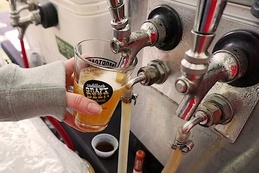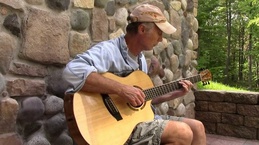Don‘t Fear the Cult
Jan. 18, 2006
Blue Öyster Cult (BÖC) has never been given their critical due. Panned by music critics of their day who preferred BÖC’s English contemporaries, Led Zeppelin and Pink Floyd, BÖC was essentially misunderstood from their name to their lyrics. Yet the heavy metal rockers gained popularity during the rise of the 1970’s stadium and arena rock movement.The band wrote thought-provoking lyrics with help of popular science fiction writers and even songstress Patti Smith who was romantically involved with the Alan Lanier (keyboardist) for seven years. Musically, BÖC was deliberate, intelligent and innovative, creating a sound that might not have resonated with critics but did with fans
The name Blue Öyster Cult caused controversy, fueling the critics. Some intepreted it as satanic. It actually comes from the symbol that means the “Cross of Questioning.” The symbol that appears on BÖC albums and all of their merchandise is patterned after the astrological symbol of Saturn (Kronos). It is in the shape of a sickle and often is referred to as the image of the God of Time in Greek mythology or in modern times referred to as The Grim Reaper.
So as BÖC begins their 39th year touring they have defied their critics. Proving that while rock journalists might not have gotten it their fans did. They will bring the heart of their original line-up (depending on when you define the band’s actual origin) in lead singer and rhythm guitarist Eric Bloom, guitar legend and vocalist Buck Dharma (defiantly with the band from day one) and keyboardist Alan Lanier to the Leelanau Sands Showroom on Saturday, January 21.
SOFT WHITE UNDERBELLY
The band’s beginnings trace back to New York City in the early 1960s and the Bouchard brothers who anchored the rhythm section of BÖC for years until pursuing other projects including the New York-based Brain Surgeons. After several line-ups and name changes they became known as Soft White Underbelly in 1967. The legendary Sandy Pearlman (of Black Sabbath, also credited for coining the term heavy metal) who produced and co-wrote several of the bands early songs managed the group.
Originally signed by Electra Records Jac Holtzman to be the East Coast version of The Doors, BÖC was fronted by Les Braunstein. When eccentric Braunstein and the band parted ways Hotlzman got cold on the band, despite Braunstein being quickly replaced by Eric Bloom (brought in by Braunstein to be the band’s sound guy), Holtzman didn’t bite.
With an Eric Bloom at the helm the group had a more intellectual sound that caught the attention of Columbia Records president, the infamous Clive Davis. Davis liked the sci-fi sound of the band and Columbia released the group’s self titled debut in 1972. The rest is as they say is history. The band enjoyed a 10-year ride and by 1980 they had established themselves as one of the greatest stadium rock bands of all time. Black Sabbath, Ted Nugent, KISS, Boston, even Bob Seger toured as BÖC opening acts.
Powered by hits such as “(Don’t Fear) The Reaper,” “Godzilla,” “Burnin’ For You,” and “Take Me Away,” BÖC captured a worldwide following of fans.
NO TRANSFUSION
But as the 1980’s metal scene took a different direction the band refused the blood transfusion. While others put on the Spandex and perm’d their hair to make it happen, BÖC stayed true to their core. By the late ’80s the scene forced the band into a short hiatus. But as other metal rockers found the Spandex getting tight around the waist and the hair starting to recede, BÖC heard the calling from their fans and the band reunited in the 1990’s for touring purposes.
While the group managed two Platinum albums and four Gold albums BÖC enjoyed a stronger showing at the box office than at the record shop. Over the years they have managed close to 10 million in record sales worldwide and recent greatest
hits compilations have made dents for the band in the soft CD sales market.
Their music continues to inspire bands and fans today. Many of today’s rock bands including The Strokes (whose current work was inspired by BÖC) use an arpeggio style by playing notes of a chord consecutively in which the individual notes (usually from lowest to highest) are played quickly one after another instead of simultaneously.
Today BÖC music is ringing a chord with new fans as well, but the issue of respect still lingers. Even the famed Saturday Night Live couldn’t get it right in 2000 when they produced a skit of the band’s recording session of their hit “(Don’t Fear) The Reaper.” Eric Bloom and Buck Dharma both chuckle at the show’s portrayal (“More Cowbell” ranks as one of SNL top-10 skits of all-time) of the band’s recording session.
‘GREAT PUBLICITY’
“I didn’t even know they were doing it and I was watching it for the first time and was laughing,” said Bloom. “I guess it was great publicity for the band but the whole account is fictional, but a lot of people saw it. They had Will Ferrell playing this fictional character Gene Frenkle who was playing the cowbell. At the end of the skit they put in memory of Gene Frenkle 1950-2000. We had all these fans coming up to us and saying it is too bad about Gene. Hell there never was a Gene Frenkle, I played the cowbell on that song.”
“They also have Eric in the skit as the lead on vocals, but I actually sang the song,” laughs Dharma. “Look, Bruce Dickinson is a great producer but he had nothing to do with the song or producing it, it was Sandy Perlman and Murray Krugman. But regardless, the skit is hilarious and I am sure with millions watching that night it helped put a spike in CD sales.”
As the group nears their 40th anniversary they are grateful for a continued interest in their music.
“I am not sure how much longer the interest will last; certainly this style of music has lasted a lot longer than my father’s music,” said Dharma. “But is has been a great run and Eric and I still enjoy writing songs together, so you never know what is in store for the future.”
The band is not releasing any information on plans for a release of any new material. The label continues to release re-masters of the band’s early albums and in 2002 the group enjoyed a successful release of a DVD of their concert at Chicago’s Navy Pier.
The road has been a long one for Blue Öyster Cult. After nearly 40 years they have proven their music doesn’t “Fear The Reaper.” The band will perform all their classic hits January 21 at the Leelanau Sands Casino Showroom. For tickets or additional information visit www.casino2win.com or call (800) 922-2949.
Nnenna Freelon
Jazz singer’s interests range from babies to Billie Holiday
By Rick Coates
Jazz vocalist Nnenna Freelon knows that she is on a long train ride that has no particular destination. It has made several stops along the way. She steps off but she always gets back on. For Freelon it has always been about the ride not the destination.
She brings her six Grammy nominations, a 25 years pf performing and six recordings with her as her musical express comes north to the Milliken Auditorium this Saturday January 21. Freelon will perform works from her current Concord Jazz label release “Blueprint of a Lady – Sketches of Billie Holiday.”
“I really do see this musical thing as about the ride or the journey,” said Freelon. “I teach several workshops to aspiring musicians and I encourage this approach. Too many people get into this work with a destination in mind. It may be money, it may be fame or winning a Grammy and once they arrive at the destination they get off the train and seem to never get back on. By not having a destination I have seen and done so many things that I might not have otherwise.”
HEY BABY
One of those “things” Freelon discovered on her destination-less train ride was “Babysong,” a program she developed in 1990 at the Duke University Medical Center to encourage new mothers to sing to their babies.
“Early in my performance career the train came to a stop. I found myself with no gigs,” said Freelon. “Had I had a destination in mind at the time I probably wouldn’t have come up with Babysong; I would have walked away or been so rooted in reaching the destination that this opportunity wouldn’t have developed.”
Freelon started thinking about how she could use her musical talents and her medical background (originally from Boston, she moved to North Carolina to pursue a Masters in health care management).
“Originally the idea was to develop a music program for newborns that were in crises but there was so much noise and things going on in these critical care units that the concept developed into a workshop that encourages parents to sing to their newborns,” said Freelon. “It is funny but American culture is the only one where it doesn’t come natural to mothers to sing to their babies. Go anywhere else in the world and singing to your babies is a natural part of the mothering process.”
The workshops have become a huge success and along with her Sound Sculpture Workshops (a music workshop for kids from K-12) Babysong is being incorporated in various communities around the country. Freelon believes that singing to and with your children is an important creative outlet for both the parent and child.
“Infants can distinguish sounds from about six months gestation. Singing to a baby is an important to nurturing and stimulating brain development,” said Freelon.
QUIET TIME
Freelon, a mother herself, believes that the lack of sound or stimulation is important as well.
“My husband and I created a “no electronic zone” for our children when they were growing up. With all this technology our children are losing that quiet time. In order to be creative you need that shut down time, a time without noise,” said Freelon. “By creating a no electronic zone you open the doors for your children. It is better than telling them to go and read a book. It forces them to become creative; eventually they will pick up a book and read on their own. Also, when they would come to me during this period and say ‘I am bored,’ I would respond, ‘Good, you can to do the dishes or do this.’ It was amazing how quickly they found things to do.”
While Freelon has enjoyed success in passing on her knowledge of music and its benefits to kids of all ages, it is her voice that will bring her to Traverse City. In the early ’90s Freelon was labeled as a “local musician,” and primarily performed in the Durham, North Carolina area. By the decades end she was an international talent with numerous awards and six Grammy nominations to her credit. Her current nomination is for the Best Jazz Vocal Album category for her “Blueprint of a Lady – Sketches of Billie Holiday,” with most industry critics touting her as the favorite.
HOLIDAY TIME
Billie Holiday has been a major inspiration to Freelon, not just her music but for what Holiday stood for as a person.
“One of the reasons I decided to name this CD a blueprint is because I wanted to create a roadmap, using her voice as a musician to build something new. It’s about taking what she stood for as an artist rather than how she sounded,” said Freelon. “It’s a simple concept that also helps build a bridge between two generations of proud black women. Imagine, a figurative grandmother and granddaughter, both reaching for truth and integrity, and channeling it the best way they know how — with music, via an incredibly powerful and expressive voice and a depth of emotion reaching both forward and backward, inwards and out.”
Freelon also feels that in many ways Holiday was misunderstood as both a person and an artist.
“A lot of information about Billie Holiday has been filtered through opinions, feelings, projections of who she was. I take it all with a grain of salt,” said Freelon. “This woman created a way for herself in a hard situation. Her art made a path for her, and her art was her refuge, a place where she felt strong, safe and invulnerable. She had some difficulties, some issues, but the way she grabbed life by the horns through her art was remarkable.
“A lot of men, especially, miss the socio-economic realities of what it meant to be a black woman in 1915,” she adds. “I did a lot of research, looked at census figures, the bigger picture. Her sometimes self-destructive behaviors were sensationalized, but she fully lived the moments that she had.”
Musically though, Freelon says there is no misinterpreting Holiday’s talents and contributions.
“Billie Holiday had an amazing capacity and ability to squeeze emotion out of a song by doing less rather than more,” said Freelon. “She was a minimalist in a way, angled to the music and swinging in her own time sense. She sang behind the beat, and you had no choice but to fix your gaze on her. She was mesmerizing, yet restrained in her music, and very beautiful.”
Freelon will also perform some of her own material. “I like to keep my shows spontaneous. I read the audience and call songs from the stage,” she said.
For additional information on Nnenna Freelon’s show, visit www.nnenna.com or visit www.dennosmuseum.org or call the box office at (231) 995-1553.
Trending

Film Review: The Map That Leads To You
As the summer blockbusters begin to fade like a sunset on the horizon and the multiplex screens fill up with the annual autu… Read More >>
Craft Beer Fest Returns to Cadillac
Now in its second decade, Cadillac’s Craft Beer Festival brings 20+ brewers to the Cadillac Commons on Saturday, Sept.… Read More >>
North Manitou Trail
James Filkins’ latest album of acoustic guitar compositions, North Manitou Trail, is available as a CD, download, and … Read More >>


